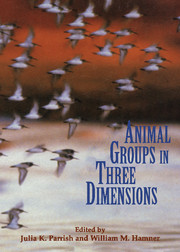Book contents
- Frontmatter
- Contents
- List of contributors
- Acknowledgments
- 1 Introduction – From individuals to aggregations: Unifying properties, global framework, and the holy grails of congregation
- Part one Imaging and measurement
- Part two Analysis
- 7 Quantitative analysis of animal movements in congregations
- 8 Movements of animals in congregations: An Eulerian analysis of bark beetle swarming
- 9 Individual decisions, traffic rules, and emergent pattern in schooling fish
- 10 Aggregate behavior in zooplankton: Phototactic swarming in four developmental stages of Coullana canadensis (Copepoda, Harpacticoida)
- Part three Behavioral ecology and evolution
- Part four Models
- References
- Subject index
- Taxonomic index
10 - Aggregate behavior in zooplankton: Phototactic swarming in four developmental stages of Coullana canadensis (Copepoda, Harpacticoida)
from Part two - Analysis
Published online by Cambridge University Press: 01 June 2010
- Frontmatter
- Contents
- List of contributors
- Acknowledgments
- 1 Introduction – From individuals to aggregations: Unifying properties, global framework, and the holy grails of congregation
- Part one Imaging and measurement
- Part two Analysis
- 7 Quantitative analysis of animal movements in congregations
- 8 Movements of animals in congregations: An Eulerian analysis of bark beetle swarming
- 9 Individual decisions, traffic rules, and emergent pattern in schooling fish
- 10 Aggregate behavior in zooplankton: Phototactic swarming in four developmental stages of Coullana canadensis (Copepoda, Harpacticoida)
- Part three Behavioral ecology and evolution
- Part four Models
- References
- Subject index
- Taxonomic index
Summary
Introduction
Zooplankton swarming
Uneven distributions of zooplankton, where concentrations can be two to three orders of magnitude greater than the average abundance, have been well documented (Ambler et al. 1991; Omori & Hamner 1982; Ueda et al. 1983; Wishner et al. 1988). Such aggregations have been considered mandatory for the survival of plankton that need to feed at high food concentrations to meet their metabolic costs (Davis et al. 1991; Lasker 1975). In attempting to quantify zooplankton patchiness, researchers have surveyed patch size and density on a broad scale (Haury & Wiebe 1982; Wiebe et al. 1985) and examined the causes of patch formation and maintenance against the forces of mixing (Okubo & Anderson 1984). Within patches, research has focused on genetic relatedness (Bucklin 1991) and physiological limitation (fish – McFarland & Okubo Ch. 19; krill–Morin et al. 1989). However, a measure of zooplankton patchiness has challenged oceanographers for years (Hamner 1988). Average densities generally underestimate local densities because conventional sampling methods, such as net sampling, can pass through several swarms (Omori & Hamner 1982). This has led to the development of new methods for assessing the true abundance and distribution of zooplankton, including SCUBA, submersibles, video-imaging, acoustics, and optical counters (Alldredge et al. 1984; Schultze et al. 1992; Smith et al. 1992; Greene & Wiebe Ch. 4). Even with these newer techniques, it is difficult to monitor patch characteristics and dynamics because patches occur over a wide range of scales (Dickey 1990; Haury et al. 1978).
- Type
- Chapter
- Information
- Animal Groups in Three DimensionsHow Species Aggregate, pp. 143 - 162Publisher: Cambridge University PressPrint publication year: 1997
- 5
- Cited by



